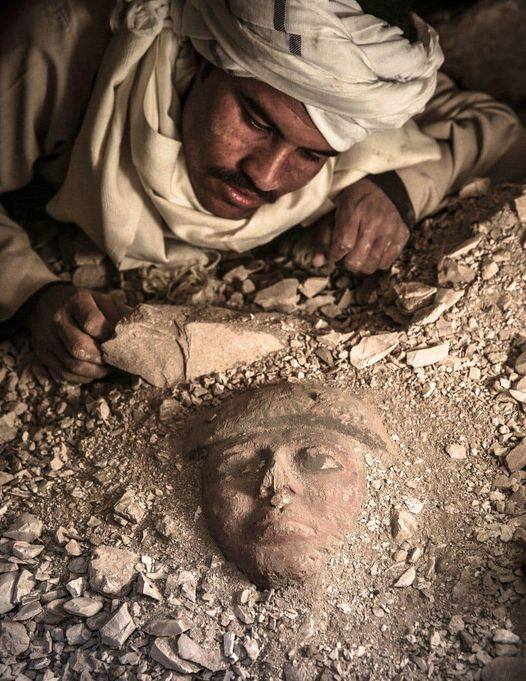Working on an archaeological dig can be hot, dirty, and exhausting, yet the experience is undeniably rewarding. The thrill of uncovering objects that have remained hidden beneath the earth for thousands of years is a feeling like no other. “I was able to experience what it is like to be the first person to see an object that has been buried for more than 3,500 years,” shared photographer Carlos Spottorno, encapsulating the profound sense of wonder that accompanies archaeological discoveries.

This sense of excitement and historical connection is what draws countless researchers, historians, and archaeologists to sites around the world, where they dedicate their lives to unveiling the mysteries of ancient civilizations. Among these endeavors is the Djehuty Project, a Spanish archaeological mission led by Dr. José Galán, which has been conducting excavations at Dra Abu El-Naga on the West Bank of Luxor, Egypt, since 2002. This site holds immense historical significance, as it is home to the tomb of Djehuty, a prominent official who served during the reign of Queen Hatshepsut in the 18th Dynasty of ancient Egypt.
Djehuty held the esteemed titles of “Overseer of Works” and “Overseer of the Treasury,” roles that placed him at the heart of both architectural endeavors and economic affairs. As “Overseer of Works,” Djehuty was responsible for supervising the craftsmen and laborers who constructed and adorned shrines and temples throughout Thebes. His contributions were pivotal in shaping the architectural landscape of the time, including the erection of two colossal obelisks at the Temple of Karnak, which stood as symbols of divine authority and royal power. In his capacity as “Overseer of the Treasury,” Djehuty played a crucial role in documenting and managing the wealth of the kingdom.
Notably, he recorded the exotic goods brought back from the legendary land of Punt during a triumphant trading expedition conducted in the ninth year of Hatshepsut’s reign. This mission, celebrated for its successful acquisition of precious commodities such as incense, gold, ebony, and exotic animals, underscored Egypt’s extensive trade networks and economic prosperity during the New Kingdom period. The tomb of Djehuty, designated as TT 11 (Theban Tomb Number 11), has become the focal point of the Djehuty Project’s ongoing investigations. This rock-cut tomb, nestled within the necropolis of Dra Abu El-Naga, offers a wealth of insights into the life, achievements, and cultural context of its esteemed occupant. Over the years, Dr. Galán’s team has meticulously excavated and documented the tomb’s architectural features, wall inscriptions, and funerary artifacts, uncovering a trove of historical and artistic treasures. Each season of excavation has yielded remarkable discoveries, contributing to a deeper understanding of ancient Egyptian society, religious beliefs, and artistic practices.
Among the most significant findings within TT 11 are the intricately carved and vividly painted wall scenes that depict various aspects of Djehuty’s life and career. These detailed reliefs not only showcase the technical prowess of ancient Egyptian artisans but also serve as visual narratives that convey the social, political, and religious dynamics of the time. Scenes illustrating the transportation of obelisks, the presentation of tribute from Punt, and the performance of funerary rituals offer valuable insights into the interconnected realms of architecture, trade, and spirituality. In addition to the tomb’s decorative elements, the Djehuty Project has unearthed a diverse array of artifacts that shed light on the material culture of ancient Thebes.
These include fragments of pottery, tools used by craftsmen, jewelry, and personal belongings that once belonged to Djehuty and his contemporaries. Each artifact serves as a tangible link to the past, providing clues about the daily lives, artistic techniques, and religious practices of the individuals who lived and worked in this vibrant city over three millennia ago. The project’s discoveries extend beyond the confines of TT 11, as the surrounding area has yielded further evidence of ancient funerary practices and cultural continuity. Adjacent tombs, burial shafts, and offering chapels have revealed additional artifacts and inscriptions, enriching the broader narrative of Theban society during the New Kingdom. Through meticulous excavation, documentation, and analysis, Dr. Galán and his team have pieced together a comprehensive picture of the social and religious landscape that defined this period of Egyptian history.
Carlos Spottorno, a renowned photographer and visual storyteller, had the opportunity to witness and document the Djehuty Project’s excavations during the 2004 and 2006 field seasons. His time with the team provided a firsthand glimpse into the daily routines, challenges, and triumphs that define life on an archaeological dig. Armed with his camera, Spottorno captured candid moments of discovery, the camaraderie among team members, and the meticulous process of unearthing and preserving ancient artifacts. Through his lens, he conveyed the passion and dedication that drive archaeologists to endure harsh conditions in their quest to unlock the secrets of the past. Spottorno’s photographs serve as a visual chronicle of the Djehuty Project’s achievements, offering a window into the world of field archaeology and the profound sense of connection that comes with uncovering long-lost remnants of human civilization.
His images not only document the physical labor involved in excavation but also capture the emotional impact of encountering objects that have remained hidden from view for thousands of years. From the careful brushing away of sand to reveal a fragment of painted relief to the moment of awe when a sealed burial chamber is opened for the first time, each photograph encapsulates the thrill of discovery and the reverence inspired by the ancient world. As the Djehuty Project continues its investigations, the team remains committed to advancing our understanding of ancient Egyptian culture and preserving the legacy of this remarkable civilization.
Through a combination of archaeological expertise, scientific analysis, and interdisciplinary collaboration, they strive to uncover new insights into the lives of individuals like Djehuty, whose contributions shaped the course of history. Their work not only enriches our knowledge of the past but also fosters a deeper appreciation for the enduring achievements of one of humanity’s most extraordinary civilizations.





